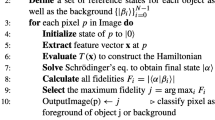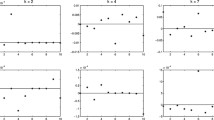Abstract
With the development of computer vision and digital image processing technology, image segmentation has become an important part of various image processing and image analysis. Since interactive segmentation can obtain more accurate results than automatic segmentation, the most representative Graph Cuts has gradually become a popular method in image segmentation. However, this algorithm has two significant disadvantages. On the one hand, if the background is complex or very similar to the foreground, the accuracy will be low; on the other hand, the algorithm is slow and the iteration process is complicated. To improve it, this paper proposes a new image segmentation algorithm based on quantum annealing and Graph Cuts. The algorithm beds the classical interactive image segmentation problem into a quantum optimization algorithm and obtains ideal image segmentation results on the D-Wave quantum annealer. Meanwhile, it is compared with the other three methods. Compared with MATLAB, the segmentation results are more beautiful, with an average precision higher than 5.27% and an average recall higher than 5.43%; the quantum annealing time is always lower than the simulated annealing time; and the success probability is more than twice that of the quantum approximate optimization algorithm. Therefore, it is concluded that this method is superior.














Similar content being viewed by others
Explore related subjects
Discover the latest articles, news and stories from top researchers in related subjects.Data availability
No datasets were generated or analyzed during the current study.
References
Wang, Z., Xu, M., Zhang, Y.: Review of quantum image processing. Arch. Comput. Methods Eng. 29(2), 737–761 (2022). https://doi.org/10.1007/s11831-021-09599-2
Gao, J., Wang, Y., Song, Z., Wang, S.: Quantum image encryption based on quantum DNA codec and pixel-level scrambling. Entropy 25(6), 865 (2023). https://doi.org/10.3390/e25060865
Zhao, J., Zhang, T., Jiang, J., Fang, T., Ma, H.: Color image encryption scheme based on alternate quantum walk and controlled Rubik’s cube. Sci. Rep. 12(1), 14253 (2022). https://doi.org/10.1038/s41598-022-18079-x
Shukla, A., Vedula, P.: A hybrid classical-quantum algorithm for digital image processing. Quantum Inf. Process. 22(1), 3 (2022). https://doi.org/10.1007/s11128-022-03755-8
Yu, Y., Gao, J., Mu, X., Wang, S.: Adaptive LSB quantum image watermarking algorithm based on Haar wavelet transforms. Quantum Inf. Process. 22(5), 180 (2023). https://doi.org/10.1007/s11128-023-03926-1
Caraiman, S., Manta, V.I.: Image segmentation on a quantum computer. Quantum Inf. Process. 14, 1693–1715 (2015). https://doi.org/10.1007/s11128-015-0932-1
Yuan, S., Zhao, W., Gao, S., Xia, S., Hang, B., Qu, H.: An adaptive threshold-based quantum image segmentation algorithm and its simulation. Quantum Inf. Process. 21(10), 359 (2022). https://doi.org/10.1007/s11128-022-03709-0
Brady, L.T., Baldwin, C.L., Bapat, A., Kharkov, Y., Gorshkov, A.V.: Optimal protocols in quantum annealing and quantum approximate optimization algorithm problems. Phys. Rev. Lett. 126(7), 070505 (2021). https://doi.org/10.1103/PhysRevLett.126.070505
Rajak, A., Suzuki, S., Dutta, A., Chakrabarti, B.K.: Quantum annealing: an overview. Philos. Trans. R. Soc. A 381(2241), 20210417 (2023). https://doi.org/10.1098/rsta.2021.0417
Chakrabarti, B.K., Leschke, H., Ray, P., Shirai, T., Tanaka, S.: Quantum annealing and computation: challenges and perspectives. Philos. Trans. R. Soc. A 381(2241), 20210419 (2023). https://doi.org/10.1098/rsta.2021.0419
King, J., Yarkoni, S., Raymond, J., Ozfidan, I., King, A.D., Nevisi, M.M., Hilton, J.P., McGeoch, C.C.: Quantum annealing amid local ruggedness and global frustration. J. Phys. Soc. Jpn. 88(6), 061007 (2019). https://doi.org/10.7566/JPSJ.88.061007
Arai, S., Oshiyama, H., Nishimori, H.: Effectiveness of quantum annealing for continuous-variable optimization. Phys. Rev. A 108(4), 042403 (2023). https://doi.org/10.1103/PhysRevA.108.042403
Li, J., Ghosh, S.: Quantum-soft qubo suppression for accurate object detection. In: European Conference on Computer Vision, pp. 158–173 (2020). Springer
Jun, K., Lee, H.: Hubo and qubo models for prime factorization. Sci. Rep. 13(1), 10080 (2023). https://doi.org/10.1038/s41598-023-36813-x
Heng, S., Kim, D., Kim, T., Han, Y.: How to solve combinatorial optimization problems using real quantum machines: a recent survey. IEEE Access 10, 120106–120121 (2022). https://doi.org/10.1109/access.2022.3218908
Nath, R.K., Thapliyal, H., Humble, T.S.: A review of machine learning classification using quantum annealing for real-world applications. SN Comput. Sci. 2, 1–11 (2021). https://doi.org/10.1007/s42979-021-00751-0
Abel, S., Blance, A., Spannowsky, M.: Quantum optimization of complex systems with a quantum annealer. Phys. Rev. A 106(4), 042607 (2022). https://doi.org/10.1103/PhysRevA.106.042607
Hegde, P.R., Passarelli, G., Scocco, A., Lucignano, P.: Genetic optimization of quantum annealing. Phys. Rev. A 105(1), 012612 (2022). https://doi.org/10.1103/PhysRevA.105.012612
Sack, S.H., Serbyn, M.: Quantum annealing initialization of the quantum approximate optimization algorithm. Quantum 5, 491 (2021). https://doi.org/10.22331/q-2021-07-01-491
Albash, T., Lidar, D.A.: Demonstration of a scaling advantage for a quantum annealer over simulated annealing. Phys. Rev. X 8(3), 031016 (2018). https://doi.org/10.1103/PhysRevX.8.031016
Schworm, P., Wu, X., Glatt, M., Aurich, J.C.: Solving flexible job shop scheduling problems in manufacturing with quantum annealing. Prod. Eng. Res. Devel. 17(1), 105–115 (2023). https://doi.org/10.1007/s11740-022-01145-8
Hegde, P.R., Passarelli, G., Cantele, G., Lucignano, P.: Deep learning optimal quantum annealing schedules for random Ising models. New J. Phys. 25(7), 073013 (2023). https://doi.org/10.1088/1367-2630/ace547
Oliviero, S.F., Leone, L., Hamma, A.: Magic-state resource theory for the ground state of the transverse-field Ising model. Phys. Rev. A 106(4), 042426 (2022). https://doi.org/10.1103/PhysRevA.106.042426
Singh, N.B., Krishna, G., Roy, A., Pachuau, J.L., Saha, A.K.: An experimental study on binary optimization using quantum annealing in D-Wave. In: 2022 Seventh International Conference on Informatics and Computing (ICIC), pp. 1–5. IEEE (2022)
Jun, K., Conley, R., Huang, Y., Lim, H., Yu, K.: Solving linear systems by quadratic unconstrained binary optimization on d-wave quantum annealing device. In: Quantum Information Science, Sensing, and Computation XIII, vol. 11726, pp. 41–47 (2021). SPIE
Pelofske, E., Hahn, G., O’Malley, D., Djidjev, H.N., Alexandrov, B.S.: Quantum annealing algorithms for Boolean tensor networks. Sci. Rep. 12(1), 8539 (2022). https://doi.org/10.1038/s41598-022-12611-9
Willsch, D., Willsch, M., Gonzalez Calaza, C.D., Jin, F., De Raedt, H., Svensson, M., Michielsen, K.: Benchmarking advantage and D-Wave 2000Q quantum annealers with exact cover problems. Quantum Inf. Process. 21(4), 141 (2022). https://doi.org/10.1007/s11128-022-03476-y
Jiang, J.-R., Chu, C.-W.: Classifying and benchmarking quantum annealing algorithms based on quadratic unconstrained binary optimization for solving NP-hard problems. IEEE Access (2023). https://doi.org/10.1109/ACCESS.2023.3318206
Zaman, M., Tanahashi, K., Tanaka, S.: Pyqubo: Python library for mapping combinatorial optimization problems to qubo form. IEEE Trans. Comput. 71(4), 838–850 (2021). https://doi.org/10.1109/TC.2021.3063618
Herman, D., Googin, C., Liu, X., Sun, Y., Galda, A., Safro, I., Pistoia, M., Alexeev, Y.: Quantum computing for finance. Nat. Rev. Phys. 5(8), 450–465 (2023). https://doi.org/10.1038/s42254-023-00603-1
Wroński, M.: Practical solving of discrete logarithm problem over prime fields using quantum annealing. In: International Conference on Computational Science, pp. 93–106 (2022). Springer
Kordzanganeh, M., Buchberger, M., Kyriacou, B., Povolotskii, M., Fischer, W., Kurkin, A., Somogyi, W., Sagingalieva, A., Pflitsch, M., Melnikov, A.: Benchmarking simulated and physical quantum processing units using quantum and hybrid algorithms. Adv. Quantum Technol. 6(8), 2300043 (2023)
Minaee, S., Boykov, Y., Porikli, F., Plaza, A., Kehtarnavaz, N., Terzopoulos, D.: Image segmentation using deep learning: a survey. IEEE Trans. Pattern Anal. Mach. Intell. 44(7), 3523–3542 (2021). https://doi.org/10.1109/TPAMI.2021.3059968
Li, Z., Chen, Q., Koltun, V.: Interactive image segmentation with latent diversity. In: Proceedings of the IEEE Conference on Computer Vision and Pattern Recognition, pp. 577–585 (2018)
Shen, X., Hertzmann, A., Jia, J., Paris, S., Price, B., Shechtman, E., Sachs, I.: Automatic portrait segmentation for image stylization. In: Computer Graphics Forum, vol. 35, pp. 93–102 (2016). Wiley Online Library
Jang, W.-D., Kim, C.-S.: Interactive image segmentation via backpropagating refinement scheme. In: Proceedings of the IEEE/CVF Conference on Computer Vision and Pattern Recognition, pp. 5297–5306 (2019)
Feng, J., Wang, X., Liu, W.: Deep graph cut network for weakly-supervised semantic segmentation. Sci. China Inf. Sci. 64, 1–12 (2021). https://doi.org/10.1007/s11432-020-3065-4
Alzahrani, Y., Boufama, B.: Biomedical image segmentation: a survey. SN Comput. Sci. 2, 1–22 (2021). https://doi.org/10.1007/s42979-021-00704-7
Nair, N.S., Nair, M.S.: Multi-view stereo using graph cuts-based depth refinement. IEEE Signal Process. Lett. 29, 1903–1907 (2022). https://doi.org/10.1109/LSP.2022.3201778
Hu, W., Yao, X., Zheng, Z., Zhang, X., Zhong, Y., Wang, X., Zhang, Y., Wang, Y.: Error attention interactive segmentation of medical image through matting and fusion, pp. 11–20 (2020). https://doi.org/10.1007/978-3-030-59861-7_2. Springer
Brust, A.F., Payton, E.J., Hobbs, T.J., Niezgoda, S.R.: Application of the maximum flow-minimum cut algorithm to segmentation and clustering of materials datasets. Microsc. Microanal. 25(4), 924–941 (2019). https://doi.org/10.1017/S1431927619014569
Chen, L., Kyng, R., Liu, Y.P., Peng, R., Gutenberg, M.P., Sachdeva, S.: Maximum flow and minimum-cost flow in almost-linear time. In: 2022 IEEE 63rd Annual Symposium on Foundations of Computer Science (FOCS), pp. 612–623 (2022). IEEE
Kovalev, K., Novichikhin, A.: Ford–Fulkerson algorithm refinement for the cooperation effectiveness increase of intensive and low-density lines. In: Journal of Physics: Conference Series, vol. 2131, p. 032008 (2021). IOP Publishing
Zaborniak, T., Sousa, R.: In situ noise characterization of the D-Wave quantum annealer. In: 2020 IEEE International Conference on Quantum Computing and Engineering (QCE), pp. 409–412 (2020). IEEE
Bajracharya, R., Shakya, S.: Task scheduling optimization in the cloud using quantum annealing. In: 2023 7th International Conference on I-SMAC (IoT in Social, Mobile, Analytics and Cloud) (I-SMAC), pp. 385–391 (2023). IEEE
Barletta, V.S., Caivano, D., Lako, A., Pal, A.: Quantum as a service architecture for security in a smart city. In: International Conference on the Quality of Information and Communications Technology, pp. 76–89 (2023). Springer
Pasetto, E., Riedel, M., Melgani, F., Michielsen, K., Cavallaro, G.: Quantum SVR for chlorophyll concentration estimation in water with remote sensing. IEEE Geosci. Remote Sens. Lett. 19, 1–5 (2022). https://doi.org/10.1109/lgrs.2022.3200325
Acknowledgements
This work was supported by the Natural Science Foundation of Shandong Province (Grant Nos. ZR2021LLZ001, ZR2022LLZ012, and ZR2021MF049) and the Major Science and Technology Research Project of Shandong Province (Grant No. 2023CXGC010901).
Author information
Authors and Affiliations
Contributions
K. formulated the overall research objectives and methods, collected relevant theoretical data, sought for relevant platforms, created the model and carried out the experimental simulation, and wrote the main manuscript text; S. participated in the model creation and experimental simulation; Q. and X. participated in the data collection; T. and H. guided and performed checking; T., as the corresponding author of this article, is responsible for the subsequent communication. All authors reviewed the manuscript.
Corresponding author
Ethics declarations
Competing interests
The authors declare no competing interests.
Additional information
Publisher's Note
Springer Nature remains neutral with regard to jurisdictional claims in published maps and institutional affiliations.
Rights and permissions
Springer Nature or its licensor (e.g. a society or other partner) holds exclusive rights to this article under a publishing agreement with the author(s) or other rightsholder(s); author self-archiving of the accepted manuscript version of this article is solely governed by the terms of such publishing agreement and applicable law.
About this article
Cite this article
Wang, K., Wang, S., Chen, Q. et al. Implementation and analysis of quantum-classical hybrid interactive image segmentation algorithm based on quantum annealer. Quantum Inf Process 23, 301 (2024). https://doi.org/10.1007/s11128-024-04512-9
Received:
Accepted:
Published:
DOI: https://doi.org/10.1007/s11128-024-04512-9




